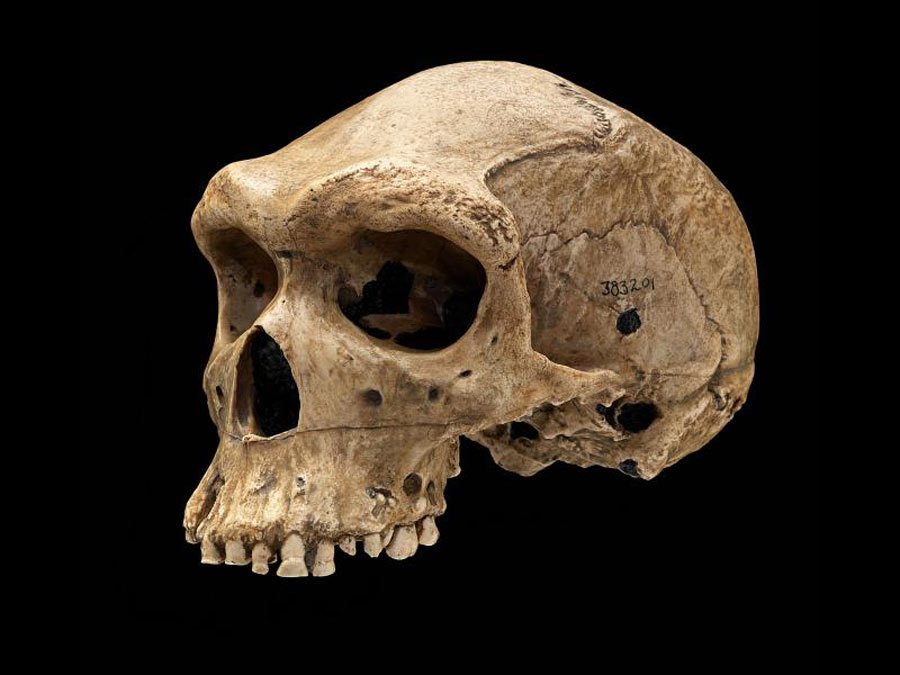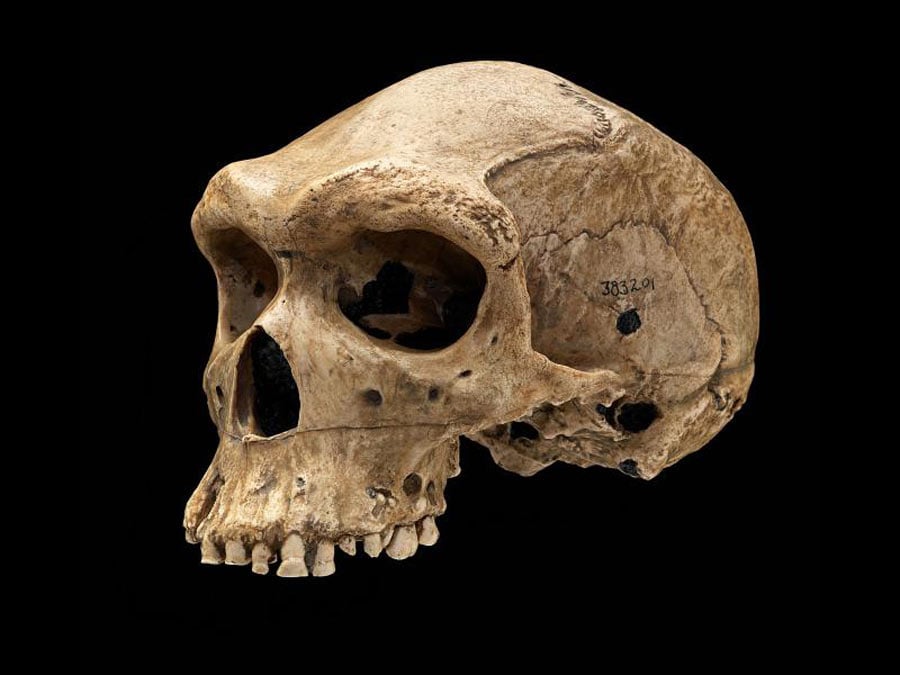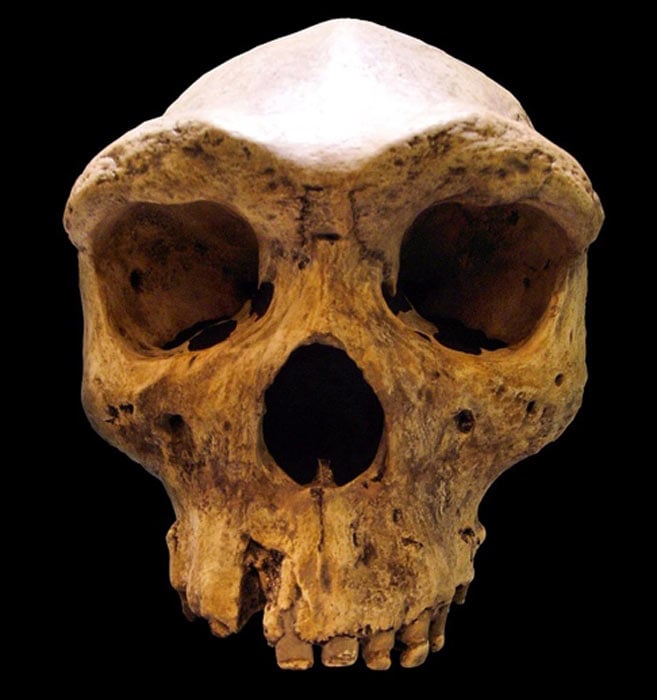
Nearly one century ago, a Swiss miner was searching for metal ore deposits in the limestone caves of Kabwe, Zambia, when he found a prehistoric skull that dated back between 125,000 and 300,000 years. It was the first fossil to be discovered in Africa with Homo sapiens characteristics.

But there was an even bigger surprise. The prehistoric skull had a small, circular shaped hole on the side, which forensic scientists say could only have been created by an extremely high-velocity projectile, such as that caused by a bullet. The mystery was compounded by the discovery of an ancient auroch skull with exactly the same feature. The discoveries have led to many wild and wonderful speculations, but we are really no closer to solving the puzzle.

Replica of the prehistoric Kabwe skull, housed in Mauer Museum, in Heidelberg, Germany. (Gerbil / CC BY-SA 3.0)
Trying to Classify Prehistoric Skulls – The Case of the Kabwe Skull
The skull found in Kabwe (also known as Broken Hill) attracted a great deal of attention when it was first discovered. According to the Smithsonian Institution, it was initially believed that the Kabwe prehistoric skull was the first ever example of a new species of hominid called Homo rhodesiensis.
It was subsequently assigned the classification of Homo heidelbergensis, although more recent research has shown that several characteristics shown similarities to Homo erectus, Homo neanderthalensis, and modern Homo sapiens. Whoever the skull belonged to, it appears he or she may have been the product of interbreeding between different hominid species.
But its unique combination of features was not all that was unique about the Kabwe skull. It was also found to have a small, perfectly-round hole on the left side of the cranium, as well as a shattered parietal plate on the opposite side.
This suggests the projectile that entered on the left side, passed through the skull with such force that it completely shattered the right side. Strangely, the presence of these highly-unusual characteristics are missing from descriptions of the Kabwe skull on the Smithsonian Institution page, as well the Natural History Museum of London, although their photos clearly depict the hole in the skull.

A replica of the prehistoric Broken Hill or Kabwe skull from the Museum in Livingstone, Zambia, with the apparent bullet hole visible on the left. (The Xenophile Historian)
What Could Have Caused the Hole in the Kabwe Skull?
While it is natural to assume that the hole may have been caused by a high-speed spear or javelin, investigations proved this was not possible. “When a skull is struck by a relatively low-velocity projectile – such as an arrow, or spear – it produces what are known as radial cracks or striations; that is, minute hairline fractures running away from the place of impact,” wrote The Shields Gazette. “As there were no radial fractures on the Neanderthal skull, it was unanimously concluded that the projectile must have had a far, far greater velocity than an arrow or spear.”
According to the book Technology of the Gods: The Incredible Sciences of the Ancients by David Hatcher Childress, a German forensics expert came to an even more radical conclusion: “the cranial damage to Rhodesian man’s skull could not have been caused by anything but a bullet.” Researcher Rene Noorbergen, who investigated the mystery in Secrets Of The Lost Races, concurred, saying that “this same feature is seen in modern victims of head wounds received from shots from a high-powered rifle.”
If this were true, it would mean that a) the skull is not as old as claimed, b) the ancient skull was shot in modern times, c) the ancient skull was shot in ancient times by a technologically advanced civilization. The first and second options are discounted by the fact that the skull was found 60 feet (18.2 m) below the surface, which confirms that it is at least several thousand years old.
It was not located near enough to ground level to have been accidently or intentionally shot in recent decades. Does that just leave us with the third option, or could there be other explanations in the mix?

Auroch skull with bullet-like hole in the forehead. (Technology of the Gods: The Incredible Sciences of the Ancients)
Turning to Other Prehistoric Skulls for Clues
Before exploring other hypotheses, we must give consideration to another prehistoric skull discovery which further compounds the mystery. Thousands of miles away, along the Lena River in Russia, another ancient skull was discovered with the same clean, round hole.
The skull belonged to an auroch, an extinct species of wile cattle that lived between 2 million and 4,000 years ago. Like the Kabwe skull, the hole in the auroch skull is also missing radial cracks that would result from spear or arrow projectiles.
The prehistoric skull, which is now on display in Moscow’s Museum of Paleontology, could not have been struck by a bullet in more modern times because calcification around the bullet hole shows that the auroch survived the wound for some time afterwards.

The Kabwe skull, or Broken Hill skull, with its bullet-like hole clearly visible on the site, on display in the National History Museum in London. (Jonathan Cardy / CC BY-SA 3.0)
Alternative Explanations for the Kabwe Skull
All these pieces of the puzzle have really brought us no closer to learning the truth. Numerous hypotheses and speculations have surfaced, from radical theories, such as the idea proposed by The Shields Gazette that “someone from the future, carrying a firearm, travelled back into the past and engaged in some sort of trans-temporal hunting expedition,” to the slightly more plausible suggestion that the holes were caused by shrapnel from a small meteorite or something similar.
In alternative archaeology circles, the most popular perspective is that ancient man may have been technologically developed to a very high degree, before virtually all traces were lost. But could two separate societies, separated by thousands of years and a vast cultural gulf, have both invented weapons that just happened to fire small, cylindrical projectiles at high speed?
The only lukewarm attempt to debunk the alternative theories comes from the Bad Archaeology website, which denies the injuries to the right-side of the skull exist. Although they present no explanation or evidence, they claim that the bullet-like hole was caused by “a pathological, rather than a traumatic lesion, caused by an infection in the soft tissue over it.”
At this stage, none of the hypotheses are supported by adequate evidence or logic. Unless more prehistoric skulls or fossils are discovered with the same type of injuries, we may never hold the real answers to the Kabwe skull enigma.
Top image: The Kabwe Skull with bullet-like hole. prehistoric skulls. Source: Jim Di Loreto and Don Hurlbert / Smithsonian Institution
By April Holloway